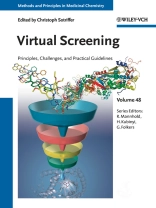Drug discovery is all about finding small molecules that interact in a desired way with larger molecules, namely proteins and other macromolecules in the human body. If the three-dimensional structures of both the small and large molecule are known, their interaction can be tested by computer simulation with a reasonable degree of accuracy. Alternatively, if active ligands are already available, molecular similarity searches can be used to find new molecules. This virtual screening can even be applied to compounds that have yet to be synthesized, as opposed to ‘real’ screening that requires cost- and labor-intensive laboratory testing with previously synthesized drug compounds.
Unique in its focus on the end user, this is a real ‘how to’ book that does not presuppose prior experience in virtual screening or a background
in computational chemistry. It is both a desktop reference and practical guide to virtual screening applications in drug discovery, offering a comprehensive and up-to-date overview. Clearly divided into four major sections, the first provides a detailed description of the methods required for and applied in virtual screening, while the second discusses the most important challenges in order to improve the impact and success of this technique. The third and fourth, practical parts contain practical guidelines and several case studies covering the most
important scenarios for new drug discovery, accompanied by general guidelines for the entire workflow of virtual screening studies.
Throughout the text, medicinal chemists from academia, as well as from large and small pharmaceutical companies report on their experience and pass on priceless practical advice on how to make best use of these powerful methods.
Tabella dei contenuti
Preface
PART I: Principles
VIRTUAL SCREENING OF CHEMICAL SPACE: FROM GENERIC COMPOUND COLLECTIONS TO TAILORED SCREENING LIBRARIES
Introduction
Concepts of Chemical Space
Concepts of Druglikeness and Leadlikeness
Diversity-Based Libraries
Focused Libraries
Virtual Combinatorial Libraries and Fragment Spaces
Databases of Chemical and Biological Information
Conclusions and Outlook
Glossary
PREPARING AND FILTERING COMPOUND DATABASES FOR VIRTUAL AND EXPERIMENTAL SCREENING
Introduction
Ligand Databases
Considering Physicochemical Properties
Undesirables
Property-Based Filtering for Selected Targets
Summary
LIGAND-BASED VIRTUAL SCREENING
Introduction
Descriptors
Search Databases and Queries
Virtual Screening Techniques
Conclusions
THE BASIS FOR TARGET-BASED VIRTUAL SCREENING: PROTEIN STRUCTURES
Introduction
Selecting a Protein Structure for Virtual Screening
Setting Up a Protein Model for v HTS
Summary
Glossary of Crystallographic Terms
PHARMACOPHORE MODELS FOR VIRTUAL SCREENING
Introduction
Compilation of Compounds
Pharmacophore Model Generation
Validation of Pharmacophore Models
Pharmacophore-Based Screening
Postprocessing of Pharmacophore-Based Screening Hits
Pharmacophore-Based Parallel Screening
Application Examples for Synthetic Compound Screening
Application Examples for Natural Product Screening
Conclusions
DOCKING METHODS FOR VIRTUAL SCREENING: PRINCIPLES AND RECENT ADVANCES
Principles of Molecular Docking
Docking-Based Virtual Screening Flowchart
Recent Advances in Docking-Based VS Methods
Future Trends in Docking
PART II: Challenges
THE CHALLENGE OF AFFINITY PREDICTION: SCORING FUNCTIONS FOR STRUCTURE-BASED VIRTUAL SCREENING
Introduction
Physicochemical Basis of Protein-Ligand Recognition
Classes of Scoring Functions
Interesting New Approaches to Scoring Functions
Comparative Assessment of Scoring Functions
Tailoring Scoring Strategies in Virtual Screening
Caveats for Development of Scoring Functions
Conclusion
PROTEIN FLEXIBILITY IN STRUCTURE-BASED VIRTUAL SCREENING: FROM MODELS TO ALGORITHMS
How Flexible Are Proteins? – A Historical Perspective
Flexible Protein Handling in Protein-Ligand Docking
Flexible Protein Handling in Docking-Based Virtual Screening
Summary
HANDLING PROTEIN FLEXIBILITY IN DOCKING AND HIGH-THROUGHPUT DOCKING: FROM ALGORITHMS TO APPLICATIONS
Introduction: Docking and High-Throughput Docking in Drug Discovery
The Challenge of Accounting for Protein Flexibility in Docking
Accounting for Protein Flexibility in Docking-Based Drug Discovery and Design
Conclusions
CONSIDERATION OF WATER AND SOLVATION EFFECTS IN VIRTUAL SCREENING
Introduction
Experimental Approaches for Analyzing Water Molecules
Computational Approaches for Analyzing Water Molecules
Water-Sensitive Virtual Screening: Approaches and Applications
Conclusions and Recommendations
PART III: Applications and Pracitcal Guidelines
APPLIED VIRTUAL SCREENING: STRATEGIES, RECOMMENDATIONS, AND CAVEATS
Introduction
What Is Virtual Screening?
Spectrum of Virtual Screening Approaches
Molecular Similarity as a Foundation and Caveat of Virtual Screening
Goals of Virtual Screening
Applicability Domain
Reference and Database Compounds
Biological Activity versus Compound Potency
Methodological Complexity and Compound Class Dependence
Search Strategies and Compound Selection
Virtual and High-Throughput Screening
Practical Applications: An Overview
LFA-1 Antagonist
Selectivity Searching
Concluding Remarks
APPLICATIONS AND SUCCESS STORIES IN VIRTUAL SCREENING
Introduction
Practical Considerations
Successful Applications of Virtual Screening
Conclusions
PART IV: Scenarios and Case Studies: Routes to Success
SCENARIOS AND CASE STUDIES: EXAMPLES FOR LIGAND-BASED VIRTUAL SCREENING
Introduction
1D Ligand-Based Virtual Screening
2D Ligand-Based Virtual Screening
3D Ligand-Based Virtual Screening
Summary
VIRTUAL SCREENING ON HOMOLOGY MODELS
Introduction
Homology Models versus Crystal Structures: Comparative Evaluation of Screening Performance
Challenges
Circa l’autore
Christoph Sotriffer is Professor for Pharmaceutical Chemistry at the University of Würzburg, Germany. He graduated as a chemist from the University of Innsbruck, Austria, where he obtained his Ph D in 1999. After conducting postdoctoral research at the University of California, San Diego, USA, and the University of Marburg, Germany, he moved to the University of Würzburg in 2006, where he has built a research group for computational medicinal chemistry. Besides structure-based drug design and virtual screening, his prime scientific interest is the computational analysis and prediction of protein-ligand interactions. His work was awarded by the Austrian Chemical Society GÖCH in 2005
and the German Chemical and Pharmaceutical Societies GDCh and DPh G in 2007.












